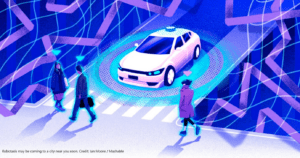Der 7. Sinn Human Crash Tests from the 1970s and 1980s – Part 1

Back in 2017, I touched on a series of crash tests done by the German TV show Der 7. Sinn in 1982 that were designed to show the benefits of seat belts. But it turns out that wasn’t the only time that they put real live human beings in the driver’s seats of cars to showcase the benefits of seat belts. They did this on at least three episodes, in 1976, 1982 and 1987.
Let’s look at the 1976 episode first. Warning: there is some somewhat graphic content (bloody injuries and naked mannequins)
It begins with an announcement that since January 1, 1976, seat belt use has been mandated in Germany. The video attempts to clear up some misconceptions about seat belts; for instance, that they will hinder escape in a fire or drowning situation and that it’s possible to brace for impact without needing a seat belt. After a couple of demonstrations involving an unrestrained egg and a restrained egg in a cardboard container hitting a wall, at 1:09 we see a stuntman strap himself into a seat with a standard 3-point belt as it’s run into a barrier at 15 kph (9 mph), much like a modern Seat Belt Convincer, followed by a second test in which the stuntman is not belted (and is thrown into a conveniently placed swimming pool). Following this, an actual car is involved in a 25 kph / 15 mph crash where another stuntman is thrown through the windshield, despite attempting to brace himself (this time onto a mat).
The message is clear: wear your seat belt, or you could be thrown out of the car even in a low speed collision.
The serious crash tests start, rather suddenly, at 2:28. We’re treated to a Ford Taunus P7 (made from 1967-1971) slamming into the rear of another car at a high speed; the video’s narration states that the car was going 80 kph / 50 mph, although this is likely before the driver hit the brakes. Still, the impact was quite severe: the front end was crushed by about a foot, and the car is obviously totaled. The impact speed was likely around 55-65 kph / 34-41 mph. The impact is described as being equivalent to a fall from 25 meters / 82 feet, or 8 stories.
At 4:02 we see our next test – another Taunus, with a real life driver, T-bones a car obscured from view. The impact speed is likely about 50 kph / 31 mph, and the driver’s door and windshield are both removed so we can see the driver’s movement. Following that we go back to our first Taunus crash, with an interior view that shows the driver’s head being thrown forward perilously close to a steering wheel replete with metal edges before unbuckling the belt and climbing out of the car. If you watch in slow motion at 4:08 – 4:10, you can see that the driver’s head comes within a few inches of that wheel and may have even hit it. They really had a lot of faith in that seat belt!
Following this test, we see another stuntman unbuckle the belt and escape from a sinking Volkswagen Beetle and then another run a Citroen DS off the road and quickly unbuckle the belt and escape from the DS before it caught fire. I’m 99% sure that fire was staged.
The human crash tests start up again at 8:23. We see an Opel, driving at 40 kph / 25 mph, hit the roof of a stationary car that had been turned onto its side. The damage is fairly minor, and the driver is uninjured.
At 9:57, we see an orange car roll down a hill. The car rolls twice; despite the windshield being thrown from the car and several inches of roof crush, the driver gets out and walks away.
Seat belts save lives – even in cars that are now over a half-century old. But, looking closer, we can see that they “stacked the odds” in favor of their drivers as much as possible, which was necessary due to the primitive state of car safety at the time. For one, our three most severe crash tests – the two frontal tests and the rollover – were conducted so that the damage would be concentrated on the passenger’s side of the car. The frontal tests were at about a 30 degree angle; the rollover test had the driver’s side go down first, because it’s the opposite side that will suffer the most roof damage. The drivers also were obviously bracing hard against the steering wheels.
The angle of the frontal tests had another, less obvious, benefit: instead of the drivers’ heads moving directly forward toward the center of the steering wheel, they moved to the right as well, giving precious extra inches to slow down due to the Pythagorean theorem. If the steering wheel is, say, 40 cm / 15.75 in in front of the driver, adding, say, 15 cm / 6 in of rightward movement gives 42.72 cm / 16.81 in of room to slow down, in addition to making any head impact more likely to be a glancing blow. And every millimeter counts when you’re at the limits of a car’s design to protect you.




